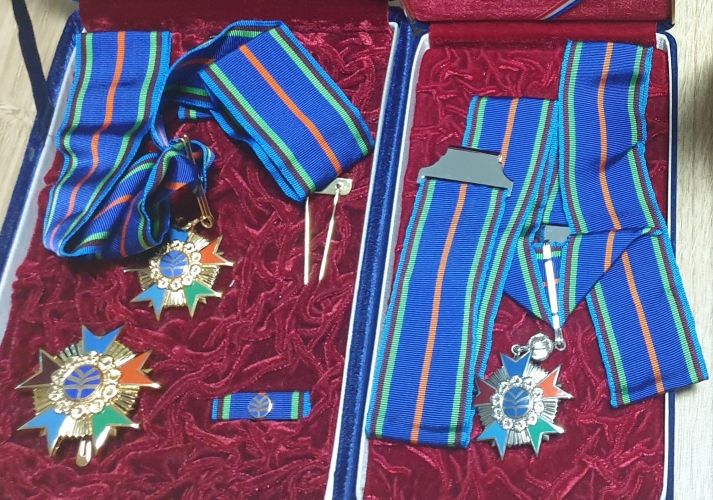
The blue center logo indicates that these are High School Level 한별단 awards.
I have not found the award criteria. The Medals are numbered on the reverse.
The Korea Youth League 한국청소년연맹 (韓國青少年聯盟) is a youth organization that was launched on March 19, 1981, by the National Security Legislative Council.1 The league is a special corporation and subject to the “Korea Youth Federation Fostering Act” 한국청소년연맹 육성에 관한 법률 (abbreviated as: Youth Federation Act 소년연맹법).2 It is administered by the Korean National Council of Youth Organizations 한국청소년단체협의회. Ultimate oversight is the responsibility of the Korean “Ministry of Gender Equality and Family”. The ‘Act on the Promotion of the Korean Youth Federation’ authorized provincial or local governments to support the organization and the activities of the federation. No other Korean youth organization receives this sort of government support. In addition, personnel who administer the program are eligible to receive Presidential and Prime Minister Awards.
The league is administered by the Korean National Council of Youth Organizations 한국청소년단체협의회. Ultimate oversight is the responsibility of the Korean “Ministry of Gender Equality and Family”. The ‘Youth Federation Act’ authorized provincial or local governments to support the organization and their activities. No other Korean youth organization receives this sort of government support. In addition, personnel who administer the program are eligible for and have received Presidential and Prime Minister Awards.
Under the administration of Korean President Chun Doo-hwan 전두환 (全斗煥1931-2021), the government established the Korean Youth Federation, under the pretext of integrating all youth organizations under government administration. Before its establishment, the Boy Scouts, Girl Scouts, the Red Cross Youth Organization, the 4H club and many other youth organizations, had already been well established in Korea. The long-term goal of the Korean Youth League was the integration of all youth groups under one umbrella. The Boy Scouts and Girl Scouts were very vocal in their protests against their inclusion in the league. Teachers who managed youth groups as part of their workload at each school level were inclined to favor the act because their work was more unified. The government continued its attempts to integrate youth organizations until the administration of President Roh Tae-woo 노태우 (盧泰愚 1932-2021). All government attempts at integration were finally stopped when the 1991 Boy Scout World Jamboree was held in Korea. After which, the Korean Youth Federation took the path of a being another youth organization rather than a means of integrating youth organizations. Currently, there are over 290,000 active members in over 8,000 schools in 19 cities and provinces across the country.
The purpose of education and training was to “establish patriotism and loyalty through intensive mental education, form a strong physical and mental discipline and a sense of unity through group training, and promote social purification and solidarity among youth through various group activities and events.”3 Many Koreans felt that it had very close parallels to Germany’s Hitler Jugend (Hitler Youth).4
In Korea, the affiliate organizations are identified by the color of the logo.
Rather than the name of ‘Korean Youth Federation’, it is better known to most Koreans by the name of its affiliated organizations, which are organized by school level. In other words, rather than the name of “Korean Youth Federation”, most people remember their membership in ‘Aramdan’ from their elementary school days, or one or more of the other affiliated organizations.

- 샛별단 Saetbyeoldan: Kindergarten, 3–7 years old.
- 아람단 Aramdan: Elementary school, 8–13 years old.
- 누리단 Nuridan: Middle School, 14–16 years old.
- 한별단 Hanbyeoldan: High School, 17–19 years old.
- 한울회 Hanulhoe: University, 20 years old and older college students.
- 보람단 Boramdan: Ministry of Labor and Youth, created for working youths.


Footnotes:
- The National Security Legislative Council was a temporary legislative body established on October 27, 1980, by Chun Doo-hwan’s new military government. His military government had seized power after the death of Park Chung-hee (Oct. 26, 1979), in a military coup (12/12/1979) and a second military coup (5/17/1980). The legislative council ceased operations on April 10, 1981.
- ‘한국청소년연맹육성에관한법률’ (81.4.13, 법률 제3434호)
- 교육훈련의 목적은 ‘집중적 정신교육을 통하여 애국심과 충성심을 정립하고 집체훈련으로 심신단련과 일체감을 형성하여 다채로운 집단활동과 행사를 통해 청소년 사회순화와 연대의식을 고취’
- From 1936 until 1945, it was the sole official boys’ youth organization in Germany, and it was partially a paramilitary organization.
